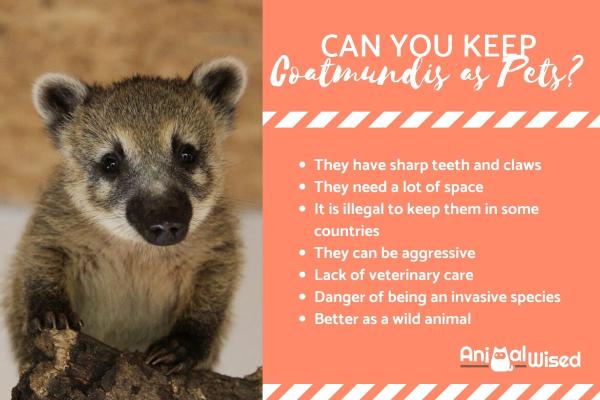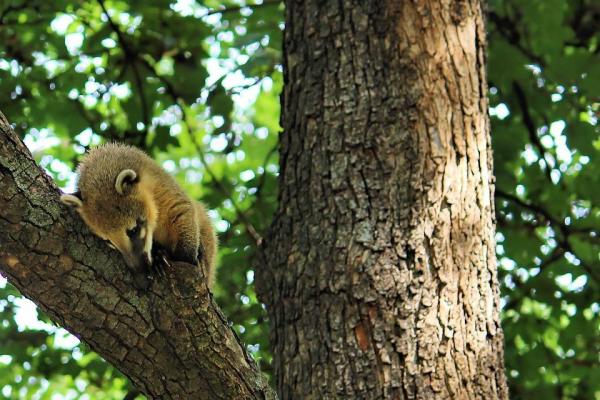
The coati or coatimundi (Nasua and Nasuella) are four different species in the Procyonidae family. This makes them closely related to the raccoon. They share several physical and behavioral traits with this animal, but coatis are recognizable for their distinct long nose. In fact, in some places they are known as a hog-nosed coon. These are certainly adorable animals, but keeping coatis as pets may not always be the best idea.
At AnimalWised, we look into coatis as pets by providin gthis guideline on their care needs and habits. We provide tips on how they are looked after and explain why they might not be a good idea for everybody.
Different types of coatis
As we state in the introduction, there are two genera which make up the species we know as the coati or coatmundi. Within these two group are several individual species, some of which also have further subspecies. These can depend on where they live as coatmundis are distributed mainly in the Americas, although there is believed to be a small (non-endemic population) in the UK:
- Nasua: the two species which make up this genus are the white-nosed coati and the South American coati. The latter is only found in South America, but the former is found ranging from Colombia all the way up to the Southwestern United States.
- Nasuella: the two main species (there are some subspecies) which make up this genus are the eastern mountain coati and the western mountain coati. The eastern mountain coati is smaller, has a shorter tail and different markings. It is also considered endangered, but the western mountain coati is not.
Less is known about the Nasuella genus and the coati from the Nasua genus are the ones most often kept as pets. Although their natural habitat is to be found in wooded areas and rainforests, keeping a a coatmundi pet has resulted in the animal appearing in places it probably shouldn't, since it can upset local ecosystems.
Let's look at some more characteristics of the coatmundi pet and what people need to consider when thinking of adopting one.
What is the white-nosed coati like?
The white-nosed coati or coatimundi, Nasua narica, is found in Central America, from Arizona in the U.S. to Ecuador. It is not an endangered species. The coati is an omnivorous animal that feeds on rodents and small vertebrates, as well as carrion, fruit, birds, berries, eggs and insects.
Adult male white-nosed coatis are solitary, while females and young males live in groups of 5 to 20. Males are expelled from the community when they reach maturity at the age of two. White-nosed coatis are very good climbers and sleep in trees at night, meaning they are partly arboreal. They tend to hunt during the day, but this can change if humans interfere or if they decide to raid rubbish bins in human environments.

How big are white-nosed coatis?
White-nosed coatis are similar in size to a medium or large-sized domestic cat. Adult males can reach up to almost 70 cm (27.5") long from the tip of their snout to the base of the tail, which can be as long as their body. Females are smaller. Their weight varies between 3 and 12 kg (7 and 46.5 lb).
These wild animals have a short, coarse and thick coat, which can vary in color from brownish-gray to black, including red and brown. Their name comes from the white area around their nose.
What is the South American coati like?
The South American coati, otherwise known as the Nasua nasua or popularly as the ring-tailed coati, is another coati species. It is somewhat larger than the white-nosed coati. Males can reach up to 115 cm (44") long and weigh up to 8 kg (16 lb). Females measure and weigh half the male's size.
Ring-tailed coatis have slightly shorter hair because they live in a warmer climate. They can be found in the tropical and subtropical forests of the area from the northern part of South America down to northern Argentina. They differ from the white-nosed coatis on account of their tail, which is patterned with dark rings.
Their diet is omnivorous, similar to that of the white-nosed coati. Solitary males occasionally practice cannibalism and eat pups of the same species. They are highly intelligent animals. Their lifespan is around 15 years of age.

Can you keep coatis as pets?
Keeping coatis as pets is not legal in every country. In fact, it is allowed in most South American countries, for instance, but not in European countries such as Spain. In fact, in 2016 coatmundis were placed on an official ‘kill list’ in Europe as they are considered an invasive species[1]. Before considering adopting a coati of any species as a pet, you will need to check your country or state's laws as it may be illegal or require a lot of paperwork.
Coatis can be tamed, but there countless cases of unwanted incidents including severe bites, destruction of furniture and escaping. They have been reported from people who have chosen to keep coatis as pets. This is not to say that there are some instances of successful adoption, because a particular coati might have had a unusually gentle character.
Coatis are cute and adorable as kittens (the word for baby coatmundis), but as soon as they reach adulthood they can become aggressive. This may be altered by neutering, but their relative rarity means it is unlikely you will be able to find a veterinarian who will be able to perform this operation. Male coatmundi pets are more dangerous than females, although a coati with her kittens will be very defensive.
Coatmundis also have very developed fangs and will not think twice about using them. Their claws are also sharp and dangerous in the domestic environment, especially around children. They are not a domesticated species and unless you are a knowledgeable animal guardian, they are not recommended to keep in the domestic environment. This is similar to keeping raccoons as pets.
There are people who breed coatis, but only to a semi-professional level. It is a relatively new practice, and it has not yet reached an acceptable standard. We do not recommend buying coatis from breeders at all.
Can you keep coatis in cages?
All articles that discuss coatis as pets mention very large cages, of 3 x 3 x 3 m (10 x 10 x 10 ft) or larger. In other words, they recommend keeping the poor animal caged and captive. Some suggest walking pet coatis on a lead in certain circumstances. Regardless, would you keep a cat or a dog trapped in a cage? What pleasure can be drawn from this sad and miserable image?
However, there is no other option. A coati cannot roam free about the house, as it would wreak havoc on the furnishings and leave it looking like a disaster site. If you keep it loose in a garden, though, it will most likely escape. Moreover, it is not at all safe to have coatis around children. You will need to create a tamper-proof cage which will be at least the size of a small bedroom with enough environmental enrichment within. This is very costly and impractical for a lot of people.
If you do keep a coati as a pet, you will need to wear thick gloves to avoid being bitten when handling it, as these animals move extremely quickly. You cannot leave them alone with children and you will always need to be aware of their behavior.
Do coatis suffer incaptivity?
It is very common for captive coatis to experience hair loss. Their tail or other areas of their body may start shedding, leaving them bald in patches. This is due to the stress of captivity, nutritional deficiencies or both. If you keep a coati as a pet, its diet will need to be supervised by a vet.

Should you keep coatis as pets?
In our opinion, the only reasonable way to enjoy a coati's company is as follows.
Coatis are very intelligent and curious. We know that they are not afraid of human environments and often wander to these places in search of food. If you live in a region where coatis live, you can simply leave some food out for them.
As coatis are diurnal (the opposite of nocturnal animals), it is very likely that you will see them come to your garden to eat your food. Leave some treats for them to enjoy, and they will surely come back. Eventually, you will build up some trust and they will let you get near.
If you provide a simple way of obtaining tasty food, the guest coati will trust you more and more. However, forget about cuddling it or scratching its belly or back. A coati will visit you and tolerate your presence if you offer food, but it will always be a wild animal at heart.
The issues with keeping a wild animal as pets are many. It is similar when keeping foxes as pets or otters in the home, they are simply better off in the wild. However, there are some other more exotic animals you can keep as pets happily such as ferrets or pigs, even if they are not as tame as cats or dogs.
If you want to read similar articles to Coatis as Pets - Guidelines and Tips, we recommend you visit our What you need to know category.
1. Irwin, A. (2916). African ibis and South American coati among 37 on EU’s kill list.
https://www.newscientist.com/article/2099675-african-ibis-and-south-american-coati-among-37-on-eus-kill-list/#